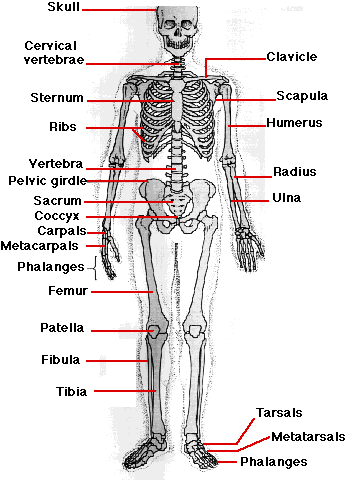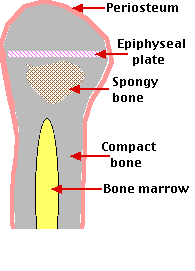
Bone
The vertebrate body is supported by an endoskeleton made of cartilage and bone. (Sharks and their relatives use only cartilage.)
The bones of the human skeleton perform several functions:
- support
- protection of internal organs from mechanical damage (e.g., skull, ribs)
- reservoir of calcium and phosphate
- source of all the blood cells.
Structure
The diagram below depicts the structure of a typical long bone such as the femur.

- Periosteum. A tissue covering the bone that brings blood and lymph vessels, as well as nerves, to it
- Compact bone (also known as cortical bone). Dense deposits of minerals — chiefly calcium phosphate — and Type I collagen.
These are arranged in
 concentric circles around a central Haversian canal through which blood and lymph vessels as well as nerves pass.
concentric circles around a central Haversian canal through which blood and lymph vessels as well as nerves pass.
- Spongy bone (also known as trabecular or cancellous bone). The mineral deposits are arranged as a system of struts. Bone marrow fill the spaces between.
- Bone marrow. Some bones, such as the femur, also contain a central cavity filled with bone marrow. Bone marrow contains the stem cells that gives rise to all the types of blood cells. [Link]
- Epiphyseal plate (also known as the growth plate). Until the end of puberty, this disk of cartilage produces more cartilage which then is converted into more bone. In this way, the bone grows lengthwise.
Looking at a skeleton, bone seems an inert thing. But in the living body it is anything but.
The size and shape of bones not only changes during growth, but for the rest one's life it is continuously being remodeled in response to the stresses put on it. Approximately 10% of your bone mass is removed and replaced each year.
The remodeling of bone requires the coordinated activity of two types of cells:
- osteoclasts, that demineralize bone in their vicinity
- osteoblasts, that secrete collagen and mineral to lay down new bone in their vicinity.
Osteoclasts are derived from stem cells in the bone marrow — the same ones produce monocytes and macrophages. [Link]
Excess activity of osteoclasts (common after menopause in women) produces osteoporosis. The bones become weakened as cortical bone gets thinner and the spaces in spongy bone get larger.
Reduced activity of osteoclasts produces osteopetrosis. This occurs when a person inherits a mutant version(s) of one or another of the genes needed for normal osteoclast function. Inhibition of osteoclast function causes too much bone to form leading to
- extra-dense bone which actually is more brittle than normal bone thus leading to fractures;
- filling-in of the bone marrow cavity with bone thus interfering with the normal production of blood cells [Link].
Many hormones affect bone growth and remodeling.
- Growth hormone (GH). As its name suggests, GH drives the growth of bones until the adult size is reached.
- Parathyroid hormone (PTH). It promotes the number and activity of osteoblasts.
- Estrogens. Until the end of puberty, estrogens are needed for maturation of the skeleton (in males as well as females — Link). In women, after the menopause, taking supplemental estrogen slows up the bone loss that so often leads to osteoporosis. The estrogen induces FasL in osteoclasts causing them to self-destruct by apoptosis and in this way slows up the destruction of bone.
- Calcitonin and thyroid stimulating hormone (TSH), both of which inhibit the activity of osteoclasts.
- Calcitriol (1,25[OH]2 vitamin D3. Needed for the deposition of calcium into bone.
- Osteoprotegerin is a protein secreted by osteoblasts and their precursors (thus a cytokine) that also inhibits the production and activity of osteoclasts. Clinical trials of a recombinant version (made in E. coli) are underway as a possible treatment for various bone-weakening disorders like osteoporosis and multiple myeloma.
- Leptin, which regulates the balance between osteoblast and osteoclast activity.
- Serotonin. Secreted by the duodenum, serotonin suppresses osteoblasts (at least in mice). This may account for the bone-weakening effect in humans of prolonged use of selective serotonin reuptake inhibitors (SSRIs).
The links above will take you to descriptions of how these hormones act.
Bone also produces hormones thus is itself an endocrine organ.
- Osteoblasts and their progeny produce a hormone — fibroblast growth factor 23 (FGF-23) — which reduces the reabsorption of phosphate by the kidneys thus allowing more phosphate to pass out in the urine and lowering the phosphate level in the blood. FGF-23 is also called phosphatonin.
- Osteoblasts also secrete osteocalcin, a hormone that stimulates the beta cells of the pancreas to release insulin. This increases the uptake of glucose by skeletal muscles thus enhancing exercise capacity. Calcitonin also stimulates the Leydig cells of the testes to release testosterone. Osteocalcin crosses the blood-brain barrier and affects neurotransmitter levels, memory, and behavior in mice and may do so in humans.
- Osteoblasts also secrete lipocalin 2, a protein containing 198 amino acids. Its level in the blood rises after a meal and suppresses further feeding (i.e., appetite).
19 March 2019
 concentric circles around a central Haversian canal through which blood and lymph vessels as well as nerves pass.
concentric circles around a central Haversian canal through which blood and lymph vessels as well as nerves pass.


 concentric circles around a central Haversian canal through which blood and lymph vessels as well as nerves pass.
concentric circles around a central Haversian canal through which blood and lymph vessels as well as nerves pass.